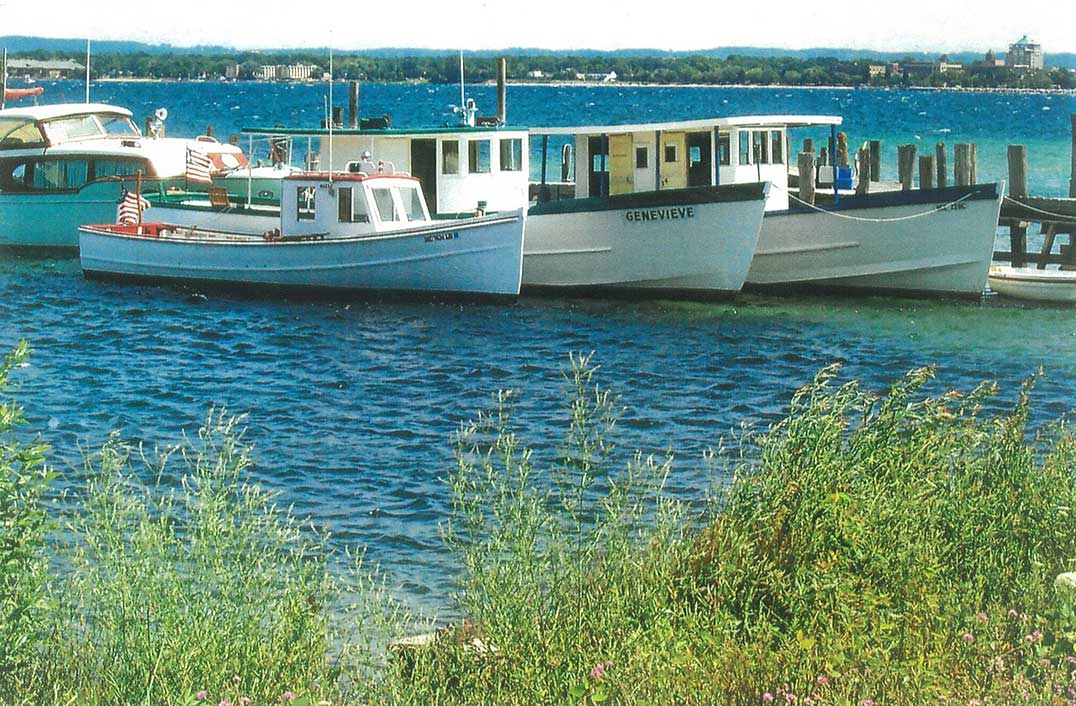by Isobel Harry
MANITOULIN—From earliest days, getting to, from and around the world’s largest freshwater island necessitated travel on water. Before roads were built on Manitoulin, First Peoples and new settlers walked long distances through bush and blizzards to cut wood, hunt and visit small settlements, while fishing, lumbering and trade with the mainland required having a water-worthy vessel as a matter of survival.
The story of Manitoulin’s early boat builders is a compelling one, as told by Bill Caesar, a passionate historian of the Island who lives on a bay within sight of the LaCloche mountains. His blue eyes twinkle as he displays first some antique boat fabrication tools and later his collection of rare fossils.
On a cycling tour of Holland, Bill and Mary Caesar found a magazine article entitled ‘Sailing Indians of the Northern Great Lakes’ that was to be the inspiration for Mr. Caesar’s small but absorbing book, ‘Northern Craft: Boats and Boat Builders of Manitoulin and Killarney.’ The former history teacher, author of several popular books on fossils, shipwrecks, lighthouses and boat builders is a living inventory of the past 150 years of boat building on Manitoulin Island and in the region.
The earliest boat pictured and described in ‘Northern Craft’ is a dugout canoe, essentially a vessel hollowed out of an elm tree. An early account is told by the late Marion Seabrook of her family arriving at their homestead on Lake Mindemoya in 1874 by a dugout canoe that then spent years “lying on the beach in front of their home, partially buried in sand.” This very canoe is in Jack’s Museum in Mindemoya (not open currently), and another similar dugout is in the Little Schoolhouse and Museum in South Baymouth.
The birch bark canoe, explains Mr. Caesar, was “a great gift from the First Nations’ people to those who came from Europe seeking a better life. Some of the most beautiful examples of these boats were made by the Algonquin and Ojibwe people.”
Mr. Caesar tells the story of Norman Middaugh of Big Lake, who went to live with the Algonquin people of the Golden Lake Reserve in Algonquin Park in about 1917. Known as ‘the blue-eyed Algonquin,’ he spent 15 years trapping and learning how canoes were built, eventually ending up in Burwash Prison for six months for trapping within the park’s boundaries. Mr. Middaugh returned to Manitoulin, eventually building many canoes for tourists who loved his fine craftmanship; one of his last canoes now hangs in the Manitoulin Hotel and Conference Centre in Little Current and another can be seen at Ten Mile Point Trading Post.
More examples of locally built bark canoes or models can be found at the Centennial Museum at Sheguiandah and the Killarney Museum. The Net Shed Museum in Meldrum Bay and the Wm Purvis Marine Museum in Gore Bay’s Harbour Centre have wonderful marine displays.
Another remarkable but little-known vessel was built on Manitoulin, commonly known as an ‘Indian working sailboat,’ but also called a ‘Mackinaw boat’ or ‘Collingwood skiff.’ “Beautiful sheer, double-ended design, massive sail area and a centre board which allowed them to navigate in extremely shallow water and to be pulled up on the shore,” says Mr. Caesar, and in 1848, 50 of these were launched in Wikwemikong alone. “Each one was different, defying any attempt to group them as a ‘class’ of sailboat.” They were between 18 and 30 feet long, with one or two masts and “extremely seaworthy” on Lake Huron and Georgian Bay from about 1845 for the next hundred years for the five generations of Ojibwe, Odawa and Pottawatomi who built them. Carrying handcrafts, maple sugar, fish, corn and blueberries to Manitoulin and passengers to and from the Sault and Parry Sound and points between, the sailboats were a common sight all over the North Channel and southern waters. A master boat builder named Joe Fournier from Sagamok “sailed the last sailboat into Little Current harbour in 1939.” Some models are upstairs in the museum at Turner’s in Little Current, but no actual old boats seem to exist anywhere except in photographs.

Sheshegwaning First Nation on Manitoulin’s West End became well-known in the 1920s and ‘30s as a boat building centre largely through the work of Joe Samson, legendary crafter of “exquisite birch bark canoes and graceful sailboats.” A photo of Joe Samson in the Wismer Collection of the Gore Bay Museum shows the tall, slender builder with a 22-foot square-sterned ‘Indian Sailboat’ under construction; one of his four-foot birch bark canoe models is occasionally on display in the Wm Purvis Marine Museum. The Commanda family were also renowned boat builders in Wikwemikong Unceded Indian Reserve in those days, adds Mr. Caesar.
Big lake steamships plied Lake Manitou before the turn of the 20th century—a note discovered on the back of a photo in Turner’s museum describes how the ‘Della S.’ took passengers two days a week “down Lake Manitou to Vanzant’s Landing—where they were met by George MaCrow [sic] who took them into Manitowaning to shop.”
We sail through the history of ‘Killarney Boats,’ built by Charlie Low for fishing; only one such working boat exists intact today, the ‘Fatima,’ built in 1951, moored at Killarney. A famous 36-foot mahogany cruiser built by one of Charlie’s sons and launched in 1947, named the ‘Jodie G,’ has been sailing for over 60 years, with a few meticulous refurbishments along the way.
Bill Caesar tells the story of the ‘Jane Miller,’ the only passenger ship ever built on the Island sank in 1881 off Colpoy’s Bay on the Bruce Peninsula; of ‘home-builts’ by Allan Morphet and Douglas Hall; of the small and practical ‘lumberyard punts’ or ‘barnyard skiffs’ built of scrap that “could hold 20 kids” and of the Berry family of Kagawong, “the most important boat building establishment in Northern Ontario over the last century.” The Berry Boats operation no longer builds the oak and white cedar designs of the early days, but is still involved in boats in Kagawong today, run by Oliver Berry’s great grandson, Oliver Newlands; two original Berry boats are in the Kagawong museum. The Purvis family’s “long and glorious history of maritime activity” is glimpsed, with a reference to Buck Longhurst’s detailed history of the family’s fishing operations, including building several tugs in Gore Bay Harbour, published as ‘A Family Tradition,’ available in the Marine Museum.
And then there’s Ham’s Marine—still operated by Dave Ham in Manitowaning after more than half a century in business, first building the ‘Manitoulin Punt,’ a flat-bottomed wooden fishing boat that sold for $50. After buying Henley Boats in the late 1990s, the company now builds distinctive heavy-duty aluminum boats “ideally suited to the local conditions.”
“Before the bridge was built, before the train came, almost everybody built boats,” says Mr. Caesar. Examples of the earliest ones do exist on the Island, but many have gone to museums in Ottawa and elsewhere. “I like to have our things stay here,” Mr. Caesar muses. “It’s our heritage.” He laments the loss of the solid brass foghorn from the Meldrum Bay Lighthouse to the Museum of Technology and of birch bark canoes to other institutions. He notes, however, that he knows of one “excellent Island woodworker,” Kurtis Aelick, who “may build an ‘Indian sailboat’ replica,” and so the historian quietly awaits the day he might clap eyes on it.
Books by Mr. Caesar, including ‘Northern Craft,’ are available at The Expositor bookstore and Ten Mile Point Trading Post.





